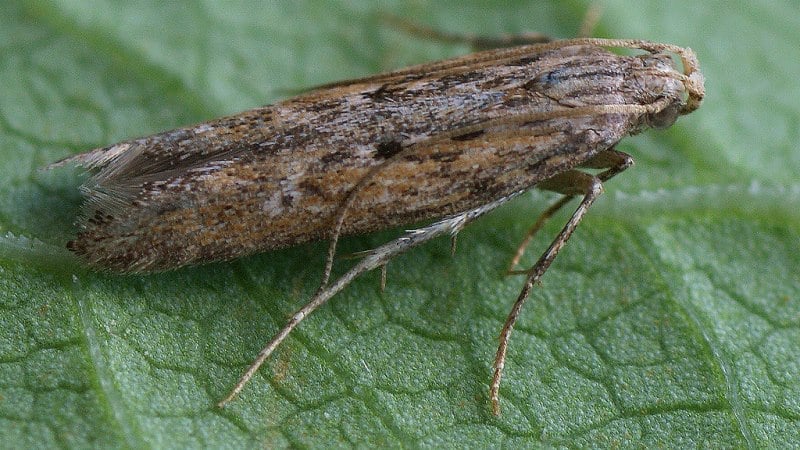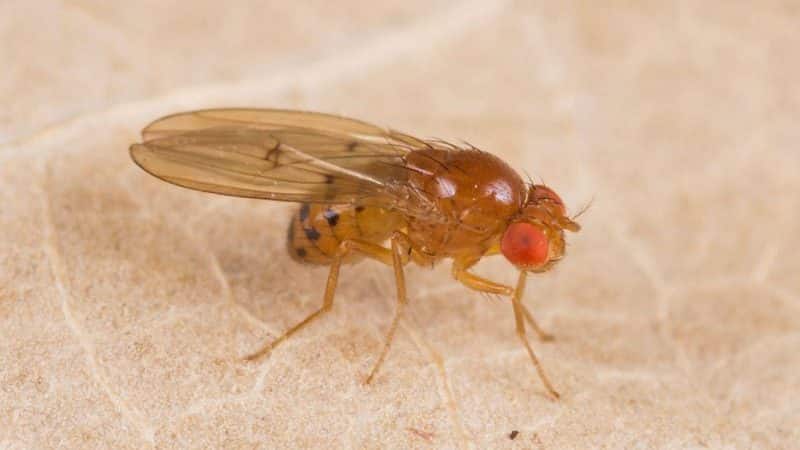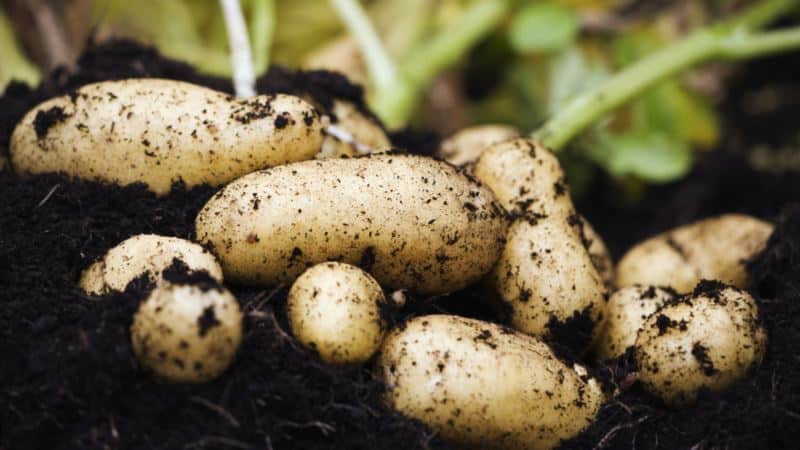How to fight potato moth and win
The potato moth is a widespread insect that causes harm to potatoes and other nightshade crops. It is difficult to detect moths at the initial stage of crop damage, which complicates the fight against these insects.
Insect larvae destroy young shoots and tubers. Tubers affected by the pest are riddled with numerous winding passages. In the fight against pest use chemical, agrotechnical and traditional methods.
Who is the potato moth?
Potato moth (fluorimea) is a heat-loving insect pest that can cause enormous damage to nightshade crops.. Its caterpillars damage many plants, but fluorimea causes maximum damage potatoes.
Moth larvae overwinter in soil and plant debris, easily tolerate temperature changes, and survive even in frozen tubers. In winter, she lives and eats in vegetable gardens. storage facilities, in which the temperature does not fall below +10°C. The pest can be found on the surface of wooden boxes in the form of attached pupae in a gray silky cocoon resembling a cobweb.
The inconspicuous potato moth is difficult to detect, since the insect leaves its shelter late in the evening. However, if you shake insect-infested potato bushes, small gray-brown butterflies will fly into the air. You will find cocoons with pupae on the outside of the leaves or in their axils.

Description and characteristics of the pest
In appearance, this is an inconspicuous butterfly with gray wings strewn with black dots, which, when the wings fold, turn into solid black stripes. The edges of the wings are uneven and wavy. The butterfly has a pronounced reduced oral cavity: the lifespan of an adult (imago) is 2-3 days, in rare cases – 7-12 days. The insect's body length is 6-7 mm.
The larvae (caterpillars) reach a length of 11-12 mm. During development, the larvae turn into pupae, then into butterflies. The length of the pupa is about 12 mm.
The caterpillars are pale pink in color, with a light longitudinal stripe along the back. The potato moth lays 0.5 mm eggs on the inside of leaves. The eggs laid are white and darken as they grow.
Reference! Larval development occurs within 3 days.
The larva turns into a silver-gray pupa.
An adult caterpillar reaches a length of 12-13 mm. Its color depends on its habitat: pests on tops have a greenish tint, while on tubers they have a white-pink tint. All species have a brown head.
Life cycle
In summer, the life cycle lasts about 30 days. During the summer, one female makes 3-4 clutches of eggs. When the temperature drops in winter, the entire cycle takes from 2 to 4 months.
The duration of pest development is affected by temperature:
- at +30…+35°C – development lasts 15-17 days;
- at +20…+28 °C – 28-30 days;
- at +13…+18°C – 65-70 days;
- at +10… +13°C – 3-4 months;
- less than +10°C – more than 4 months.
On average, during warm summer months, 30-35 days pass from the moment of egg laying to the sexually mature stage.
Adults live no more than 10-14 days. During this time they mate and lay eggs.One clutch usually contains 18-20 eggs; in 14-20 days the butterfly lays about 200 eggs.
In 3-6 days, caterpillars mature inside the eggs. Within 10-15 days, they spin a cocoon for themselves, turning into pupae. Within 5 days, butterflies emerge from the pupae, which immediately mate and lay eggs.
Pupae can overwinter under the remains of tops or in vegetable rooms. In spring, new butterflies attack potato fields.
What does she eat?
The potato moth has a keen sense of smell; it can smell potatoes even through bags. If a potato crop is left in a field, butterflies immediately colonize it.
Insect caterpillars settle inside tubers, which serve as their main food, gradually destroying the crop during winter storage.
The larvae of the pest are omnivorous; in the summer, leaves, young shoots, and fruits become their victims.
Where do potato flies come from?
The spread of the pest occurs by moving them from potato beds to vegetable warehouses for winter storage of the crop. They overwinter in potatoes, and in the spring they move in planting material to areas. The pest can overwinter under uncollected plant debris on the soil.

Are they dangerous and what is their harm?
The insect parasitizes both in open ground and in vegetable warehouses. Potato moth caterpillars cause harm.
What harms potatoes?
Potato moth caterpillars:
- destroy the green mass of plants, which leads to weakening of vegetable crops;
- they damage the tubers, after which the crop becomes unsuitable for consumption and storage;
- under favorable conditions for insects, the larvae can completely destroy the crop;
- Caterpillars at high speed destroy first tender leaves and young shoots, then adult plants; insects cause the greatest damage to ripening tubers.
Is it harmful to humans?
Potato moth destroys nightshade crops. The insect does not directly harm humans, but tubers riddled and eaten by caterpillars become unsuitable for consumption.
Signs of pest damage
The presence of an insect can be detected by examining the central vein of the outer side of the leaves. When colonized by moths, cobwebs and insect excrement are visible. The caterpillars feed on the outside of the leaves, after which the leaves become deformed and dry out.
Insects quickly move along the leaves, feeding on them, then move onto the potatoes. Wherever pests have been, excrement and cobwebs are visible. Parasites enter tubers through cracks in the soil and eyes. Numerous thin passages are visible on the cut of the affected tuber. Damaged vegetables take on an ugly shape.
Such potatoes become inedible.
How to get rid of potato moth
Potato moths are eliminated by a set of measures, including chemical, agrotechnical and folk remedies. Great importance is attached to preventive measures.
Effective insect control methods slow down the development and growth of the pest at all stages.
Chemicals
When butterflies appear on a crop before flowering, the following drugs are used:
- "Bitoxibacillin" - has an intestinal effect on insects, does not cause adaptation. To prepare a working solution, 100 ml of the drug is diluted in 10 liters of water. Spraying of bushes is carried out in the morning or evening hours. Treating bushes with this drug will destroy the larvae and reduce the fertility of females.
- "Dendrobacillin" — used to destroy caterpillars in the initial and middle stages of development. Prepare a solution consisting of 70-100 g of insecticide and 10 liters of water. Carry out double treatment with an interval of 7 days. If necessary, the treatment is repeated after a month.
- "Lepidocide" – a microbiological insecticide used at all stages of crop vegetation, including the period before harvest. The drug does not affect the taste characteristics of potatoes and does not accumulate in the soil. To spray bushes, 30-50 ml of the drug is diluted in 5 liters of water. Plants are treated twice with an interval of 10 days.
Also at the beginning of summer, the drugs “Arrivo”, “Decis”, “Inta-VIR”, “Sherpa” are used. The treatment is repeated after two weeks, alternating medications.
Attention! The last chemical treatment is carried out no later than 20 days before harvest.
Traditional methods
To combat potato moths, folk remedies are used to reduce the number of parasites in potato beds.
- A glass of crushed wormwood and a glass of wood ash are poured into 3 liters of boiling water and left for 3-4 hours. The infusion is filtered and sprayed on the plants, wetting the underside of the leaves.
- Soak 250 g of wormwood, 50-80 g of onion peels, and 100 g of grated laundry soap in 5 liters of water. The composition is brought to a boil, kept for 2-3 hours and the culture is sprayed.
- Leaves and stems of celandine in an amount of 1 kg are boiled for 7-10 minutes. in 5 liters of water, then cool. For spraying, the mixture is further diluted with another 5 liters of water.
To attract moths, traps are prepared: chopped fruits filled with sweet syrup are placed in small containers. The moths accumulated in the syrup are destroyed.
Agrotechnical methods

In the fight against potato moth, agrotechnical measures are important:
- Tubers are planted at the maximum permissible depth, since the pest quickly attacks vegetables located close to the soil surface.
- The beds are regularly hilled so that the thickness of the layer above the tubers is at least 15 cm. With such a layer of soil, it is more difficult for insects to get to the fruits.
- The harvest is harvested until the tops dry out completely. Many gardeners mow the tops 7-10 days before the intended harvest and immediately remove them from the beds so that the pest does not move onto the tubers.
- Some farmers warm up the planting material. This destroys most of the larvae.
Timely removal of weeds will reduce the population of the parasitic insect, since the moth often settles in thickets of wild nightshade plants, then moves to vegetable crops.
Important! The larvae in the tubers die at +40°C. Warming up is carried out for 2-3 hours.
Post-harvest struggle
It is not recommended to leave the harvested crop on the beds; a pest may remain on the tops, which will immediately move to the tubers.
To prevent insects from multiplying in the beds, the tops are immediately removed from the beds and the soil is dug up.
How to treat potatoes against moths when storing them
To protect the crop from parasitic insects, the harvested potatoes are immersed for 5-7 minutes in a 1% solution of biological products: “Lepidocide” or “Bitoxy-bacillin” (100 g of the drug per 10 liters of water). After this, the potatoes are dried and then placed in winter storage.
Also, for processing the crop, a composition is prepared from the biological preparations “Lepidocida” and “Planriza.” “Planriz” is added to prevent fungal infections. 200 ml of Lepidocide and 50 ml of Planriza are diluted in 10 liters of water. Potatoes are soaked in this mixture for 10-15 minutes.After this, the root vegetables are dried.
Attention! It is not recommended to store the solution of biological components; it is used immediately after preparation.
To destroy moth larvae on the crop, tubers are treated with a solution of ethyl bromide.
How to prevent potato flies
Before landing crops conduct a thorough inspection of the seed. The skin of the tubers should be without holes, indicating the presence of larvae.
Before storing the crop, the vegetable storage room is disinfected by whitewashing the walls with quicklime.
To kill butterflies, smoke bombs “Gamma”, “Fas” or fumigants are used.
Treating the room and tubers with a solution of the biological preparation “Entobacterin” will help prevent the appearance of moths. After treating the premises, adult insects lose activity and are not able to lay eggs in root crops.
Tips and tricks
Farmers have noticed that if a little wood ash is poured into each hole during planting, the likelihood of tubers being damaged by caterpillars is reduced.
For prevention, proper crop rotation is observed: potatoes are not planted on the site after growing other nightshade crops.
Important! It is not recommended to plant potatoes in one area for several years in a row.
To protect root crops from damage by moth larvae, hill up the beds regularly.
Watering potato bushes using the sprinkling method will significantly reduce the number of pests. This will lead to the death of most of the adult butterflies.
Conclusion
Potato moth is a common insectpest, the larvae of which are capable of destroying young shoots, adult plants, tubers in the ground and harvested crops during storage.
The fight against this pest is complex: traditional methods, chemicals, compliance with the correct agricultural techniques for growing, processing the site and seed before planting in open ground.